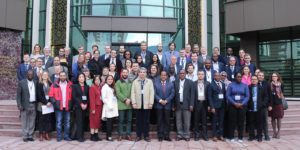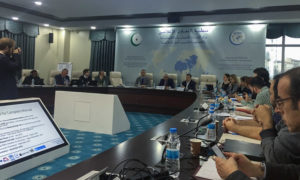With the International Recommendations on Refugee Statistics and the upcoming recommendations on IDP statistics, the Expert Group on Refugee and IDP Statistics (EGRIS) has already come a long way to help improve the collection and interpretation of official statistics on forcibly displaced persons. However, it is crucial that these recommendations are translated into practice: so how can they be concretely implemented on national and international level?
This is exactly what members of the Expert Group worked on at the third all-members meeting in Ankara, Turkey, in February 2019. The main focus was on refining the draft Compilers Manual – a practical guide structured around the eight phases of the Generic Statistical Business Process Model (GSBPM) with the addition of a phase on coordination. During the meeting the Expert Group members had group discussions on core topics from each of the nine defined phases of the statistical production process. More concretely, the meeting provided an opportunity to look at what is needed to identify refugees and IDPs within the different types of data sources, as well as what is required technically and in terms of coordination to establish regular production of official statistics on refugees and IDPs.
The majority of the now 45 member countries as well as international organisations and technical experts took part in the meeting. As part of the Steering Committee of EGRIS, JIPS contributed to shaping the outline of the manual and helped preparing and facilitating working sessions.

Credit: UNHCR
Building on the International Recommendations on Refugee Statistics (IRRS) and the soon-to-come recommendations on IDP statistics, the Compliers Manual is intended to serve as a practical guide for producers of official statistics to help them improve the collection and interpretation of evidence on forced displacement situations.
While the manual aims to provide useful guidance to all types of actors producing statistics on forced displacement situations, it puts the national statistical systems (NSS) and the national statistics offices (NSOs) at the centre of the process: they are key actors in producing official statistics and main guardians of the quality standards that need to be fulfilled in the production and dissemination of official statistics.
During dedicated working sessions, Expert Group members discussed the different phases of the manual in order to shape up the work modalities, milestones and content for each phase. In fact, the manual is structured around the above-shown Generic Statistical Business Process Model (GSBPM) – a common framework widely used by actors at national and international levels that describes “the statistical production process in terms of standard components (eight phases and their sub-processes). It is intended to apply to all activities undertaken by producers of official statistics (… and) designed to be independent of the data source” (source: UNECE’s statswiki). For the purpose of guiding statistics production on forced displacement, the manual includes an additional phase 0 on coordination.
Multiple statistics producers – national and local statistics offices, but very often various humanitarian and development actors at national and international level – currently publish data on the forced displacement situation in a given country. In most cases, the data produced isn’t adequate to inform official statistics as it serves operational purposes of specific organisations but doesn’t fulfil the requisite quality standards for official statistics.
We have already made important progress towards establishing international standards and guidance on the data production process (through the IRRS, IRIS and Compilers Manual) in order to mitigate some of the quality assurance challenges that operational data faces, namely by following common standards on methods and definitions as well as committing to transparency of methodology.
In addition, however, we also need improved coordination mechanisms that define clear rules as well as roles and responsibilities of the different statistics producers in the collection, validation and dissemination of official statistics at national level. This would also help ensure data sharing, good communication between international agencies and national NSOs, as well as collaborative mechanisms among international, regional and national statistical systems and displacement data producers.

The EGRIS meeting was hosted by the Statistical, Economic and Social Research and Training Centre for Islamic Countries (SESRIC), in Ankara (Turkey).
The subgroup on the coordination phase, co-led by JIPS, is currently looking at defining mandates, reporting and collection procedures, identifying obstacles to improved coherence between national and international collectors of displacement statistics and how to overcome them. This includes:
A full day was dedicated to the discussion of different data sources, and more specifically to the question of what is needed to identify refugees and IDPs within these data collection types. We looked at four types of sources: administrative data, censuses, surveys, and integrated data sources (more on this in another article – stay tuned!).
Several EGRIS members also shared with the wider Expert Group how they were already working to implement the recommendations on refugee and IDP statistics into their respective data systems, including:
We will make sure to continue updating you on progress made through the Expert Group as well as its IDP subgroup. As a next step, we are working to further shape up the content for the Compilers Manual and finalise the IRIS. An internal review round among EGRIS members will take place by September, and submission for global consultations with the members of the UN Statistical Commission is planned for November 2019.
We will also take a closer look at how integrated data could help improve IDP statistics, and give the floor to Ukraine on how they are already working to implement the IRIS inspired by their participation in the EGRIS process.